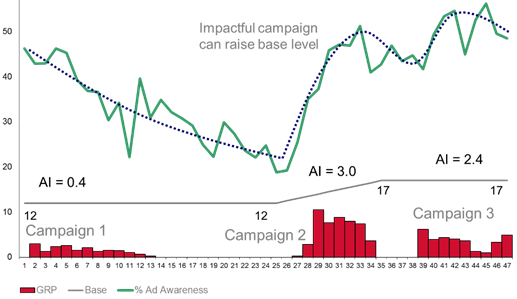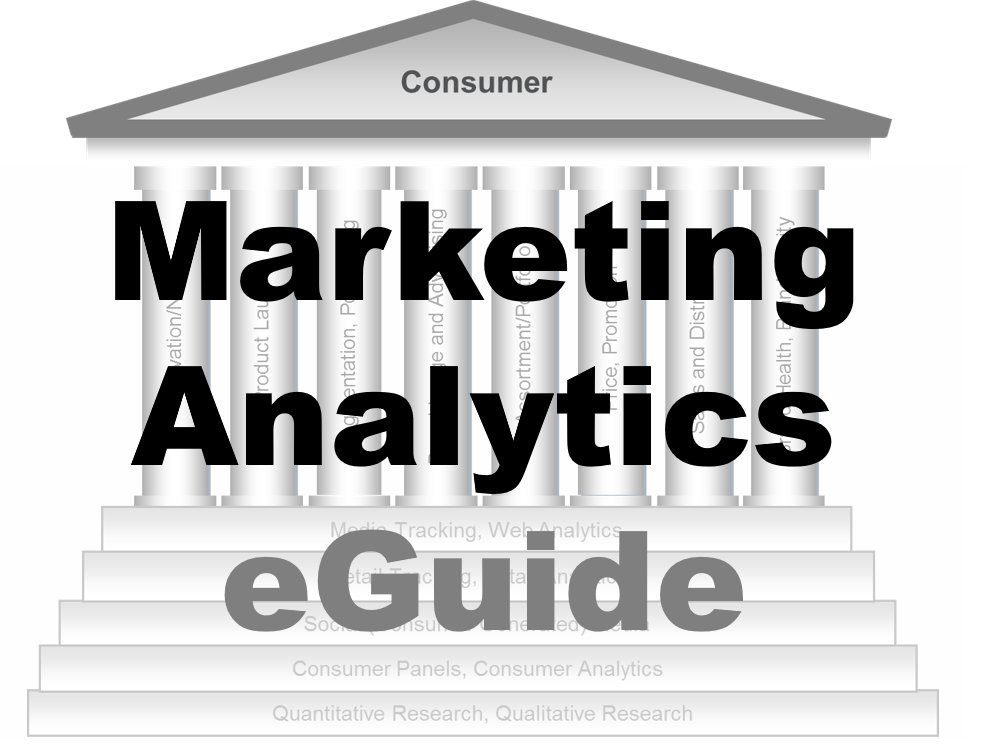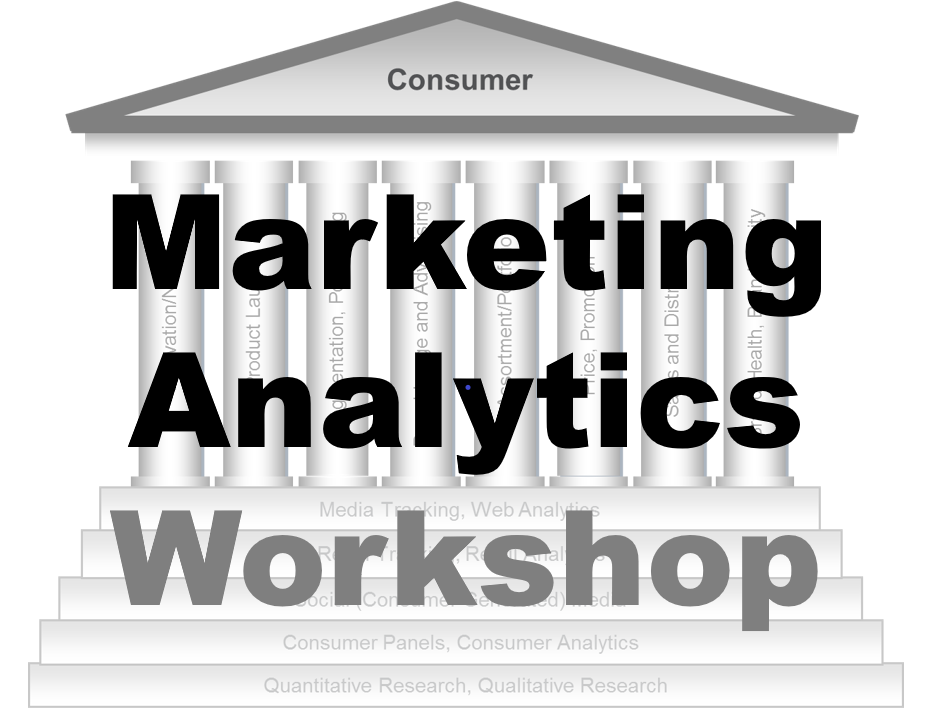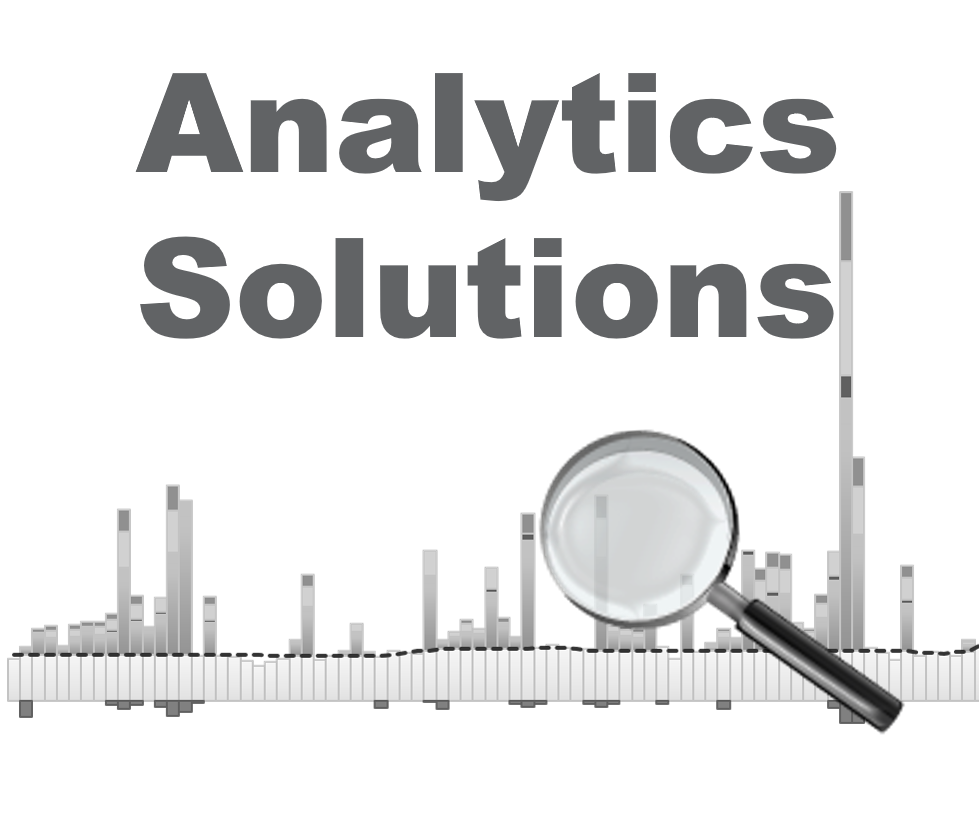-
Advertising Analytics
Advertising Analytics
Audience Measurement
OTT Services
Internet Protocol TV
Return Path Data
Viewer Analytics
Gross Rating Points
Digital Audience Measurement
Total Audience Measurement
Copy Testing
Testing Advertising Online
Advertising Tracking
Continuous vs. Dipstick
Tracking Questionnaire
Advertising Engagement
Behavioural Engagement
YouTube Analytics
Attitudinal Engagement
Branded Memorability
Persuasion
Uniqueness
Likeability
Image and Symbolism
Involvement
Communication
Emotion
Case — Molly LFHC
Awareness Index Model
- How Advertising Works
- Advertising Analytics
- Packaging
- Biometrics
- Marketing Education
- Is Marketing Education Fluffy and Weak?
- How to Choose the Right Marketing Simulator
- Self-Learners: Experiential Learning to Adapt to the New Age of Marketing
- Negotiation Skills Training for Retailers, Marketers, Trade Marketers and Category Managers
- Simulators becoming essential Training Platforms
- What they SHOULD TEACH at Business Schools
- Experiential Learning through Marketing Simulators
-
MarketingMind
Advertising Analytics
Advertising Analytics
Audience Measurement
OTT Services
Internet Protocol TV
Return Path Data
Viewer Analytics
Gross Rating Points
Digital Audience Measurement
Total Audience Measurement
Copy Testing
Testing Advertising Online
Advertising Tracking
Continuous vs. Dipstick
Tracking Questionnaire
Advertising Engagement
Behavioural Engagement
YouTube Analytics
Attitudinal Engagement
Branded Memorability
Persuasion
Uniqueness
Likeability
Image and Symbolism
Involvement
Communication
Emotion
Case — Molly LFHC
Awareness Index Model
- How Advertising Works
- Advertising Analytics
- Packaging
- Biometrics
- Marketing Education
- Is Marketing Education Fluffy and Weak?
- How to Choose the Right Marketing Simulator
- Self-Learners: Experiential Learning to Adapt to the New Age of Marketing
- Negotiation Skills Training for Retailers, Marketers, Trade Marketers and Category Managers
- Simulators becoming essential Training Platforms
- What they SHOULD TEACH at Business Schools
- Experiential Learning through Marketing Simulators
Awareness Index Model
Market response models use statistical methods of analysis of historic market data, to estimate the impact of advertising and other elements of the marketing mix on sales. The topic is covered in Chapter Marketing mix Modelling.
This section is devoted to Millward Brown’s Awareness Index (AI), a widely used measure of the efficiency of advertising in generating advertising awareness. It’s origin dates back to 1986, when Gordon Brown introduced the notion of the awareness index in his paper, “Modelling Advertising Awareness”.
The model is based on the premise that advertising awareness depends on:
- Quantum (GRP)
- Current GRP, past GRP
- Quality (ad content)
- Advertising heritage, i.e., prior legacy of advertising
The measure used for advertising awareness is brand-led claimed advertising awareness: “Have you seen any advertising for [brand] recently?” The word “recently” curtails the time frame so that conclusions relate largely to current or recent campaigns.
In the model, Awareness Index represents the incremental level of claimed ad recall generated per 100 GRPs.
The Base level is the level to which recall will gradually decline when advertising stops. A reflection of advertising heritage, it represents the proportion of people who would claim to be aware of recent advertising, even if there is no advertising for some time.
Brands with historically high levels of memorable advertising tend to have higher base levels. Brands without memorable advertising or without much advertising history have low base levels.
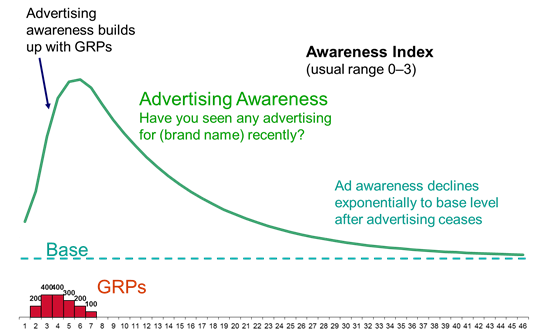
Exhibit 13.21 Awareness index and base.
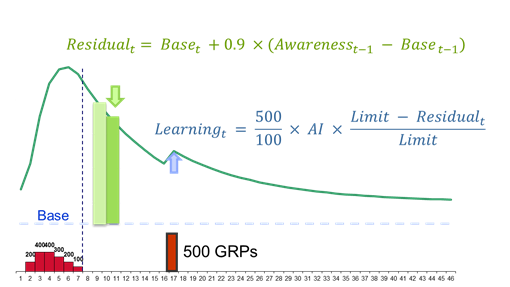 Exhibit 13.22 Residual awareness and learning.
click to download illustration
Exhibit 13.22 Residual awareness and learning.
click to download illustration
The model states that awareness is a combination of residual awareness from previous advertising plus learning.
As shown in Exhibits 13.21 and 13.22, when advertising stops, ad awareness decays exponentially towards base level, and for any week, learning is the gain in ad awareness due to the brand’s advertising in that week. $$ Awareness (A_t) = Residual Awareness (R_t) + Learning $$ $$ R_t = Base_t + Retention ×(A_{t-1} - Base_{t-1}) $$ $$ Base_t = Base_{t-1}+ constant $$ $$ Learning = Awareness Index (AI) × \frac{GRP}{100} × \frac{Limit - R_t}{Limit} $$ $$ Retention = 0.9,\,Limit=90 $$ $$ A_t=Base_t +0.9(A_{t-1}-Base_{t-1})+AI×\frac{GRP}{100}×\frac{90-[Base_t+0.9(A_{t-1}-Base_{t-1})]}{90} $$
The maximum possible claimed awareness level (limit) and the retention rate are hard-wired into the model:
- Retention rate is assumed to be 90%. In other words, awareness decays exponentially at the rate of 10% to the base level.
- Limit = 90, i.e., the maximum achievable awareness level is 90%.
The base line is assumed to be linear, increasing (or decreasing) gradually at a constant rate every period. And since the retention rate (0.9) is fixed, the pace at which advertising declines is determined by the base level.
Established brands usually have a fixed base level that remains stable over a period of 2 to 3 years. It is rare for ad campaigns to significantly raise base levels and only exceptionally powerful and memorable campaigns have the potential to do so.
One challenge with the Awareness Index model is that the base level and awareness index are interdependent, meaning that there are multiple combinations of these two factors that can fit the model equally well.
To address this, the modeller typically sets the baseline based on their experience and norms sourced from a database of historical studies. This helps to establish a starting point for determining the most effective advertising strategies for a particular brand.
Despite this challenge, the Awareness Index model remains a valuable tool for advertisers, as it provides a structured approach to assessing the impact of advertising on brand recall.
One of the strengths of the model is its ability to distinguish the performance of different advertising campaigns, as illustrated by the analysis in Exhibit 13.23. The exhibit pertains to the advertisements of Surf Ultra, a concentrated detergent powder, soon after its launch in India. The model reveals that Campaign 2, which featured the memorable “daag dhondte reh jaonge” (you'll keep searching for the stain) commercial, registered a high awareness index of 3.0 and succeeded in raising the base level.
In contrast, the initial campaign for Surf Ultra was relatively weak. Diagnostics for that campaign revealed the inability of the campaign to differentiate the concentrate variant, Surf Ultra, from Surf, the mother brand.
Overall, the Awareness Index model can help advertisers make informed decisions about their advertising strategies, enabling them to develop more effective campaigns that resonate with their target audience and drive brand recall.
Previous
Use the Search Bar to find content on MarketingMind.
Contact | Privacy Statement | Disclaimer: Opinions and views expressed on www.ashokcharan.com are the author’s personal views, and do not represent the official views of the National University of Singapore (NUS) or the NUS Business School | © Copyright 2013-2025 www.ashokcharan.com. All Rights Reserved.

